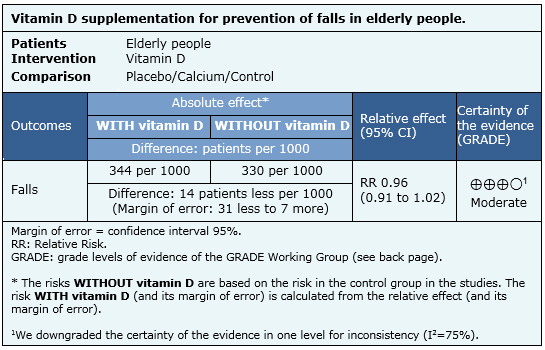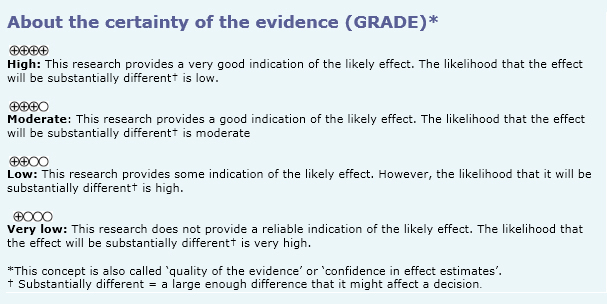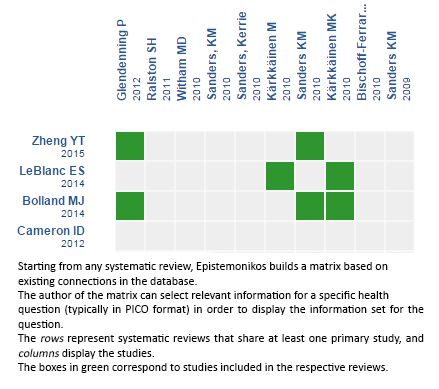Resúmenes Epistemonikos
← vista completaPublicado el 27 de enero de 2016 | http://doi.org/10.5867/medwave.2016.6368
¿Es efectiva la suplementación con vitamina D para la prevención de caídas en pacientes geriátricos?
Is vitamin D supplementation effective for the prevention of falls in elderly people?
Abstract
Falls in elderly people are common and come with important effects on morbidity and mortality, dependence and institutionalization. It has been proposed that supplementation of vitamin D could prevent the occurrence of this event. Searching in Epistemonikos database, which is maintained by screening 30 databases, we identified 18 systematic reviews including 31 randomized trials. We combined the evidence using meta-analysis and generated a summary of findings table following the GRADE approach. We concluded the use of vitamin D probably leads to little or no difference in the risk of falling in elderly people.
Problem
Falls syndrome is an important problem in geriatric population. The third part of patients above 65 years old experience a fall every year and the risk of falling increases with age [1],[2]. Approximately, one of ten people would have serious consequences, such as bone fracture, subdural hematoma, soft tissue injury or cranial trauma [3],[4],[5]. On the other hand, it is associated with a decrease in functionality and earlier entry to care facilities and hospitals [6].
Vitamin D has diverse physiological effects due to the existence of 1,25-hydroxi-vitamin D receptors around the majority of the human body tissues. The presence of these receptors in muscles would explain the relationship between vitamin D deficiency and myopathy, weakness and muscular pain [7]. It has been proposed that supplementation of vitamin D would lead to an improvement in muscular strength and prevention of falls [8],[9], even in patients with no vitamin D deficiency.
Methods
We used Epistemonikos database, which is maintained by screening more than 30 databases, to identify systematic reviews and their included primary studies. With this information we generated a structured summary using a pre-established format, which includes key messages, a summary of the body of evidence (presented as an evidence matrix in Epistemonikos), meta-analysis of the total of studies, a summary of findings table following the GRADE approach and a table of other considerations for decision-making.
|
Key messages
|
About the body of evidence for this question
|
What is the evidence. |
We found 18 systematic reviews [10],[11],[12],[13],[14],[15],[16],[17],[18],[19], |
|
What types of patients were included |
The patients that were included corresponded to elderly people (65 years or above) in care facilities, hospitals or patients living in the community. Studies did not restrict their inclusion criteria according to levels of vitamin D prior to supplementation. Most patients were women. |
|
What types of interventions were included |
Interventions varied regarding calcium combination, doses, schemes and ways of administration of vitamin D. Twenty-four different ways of intervention were identified including vitamin D. Thirteen studies [9],[34],[39],[49],[51],[63],[64],[68],[69],[70],[75],[76], [83],[84] included calcium in the intervention group. Different vitamin D doses schemes were used. Doses under 800 Ul per day were used in six different studies [34],[38], [49],[58],[60],[64]. In 22 studies [8],[9],[30],[38],[39],[45],[49],[51],[58],[60],[61],[63], In other two studies [82],[87] it was used annually and in three studies [18],[43],[61] in a single dose. The comparison was against placebo, control group, strategies for falling prevention and calcium administration in 600 mg, 1000 mg and 1200 mg doses. |
|
What types of outcomes |
This summary, as well as the majority of the identified reviews, analyses only the outcome of falls. |
|
We found three systematic reviews [5], [6], [7], including 14 studies reported in 21 references [8], [9], [10], [11], [12], [13], [14], [15], [16], [17], [18], [19], [20], [21], [22], [23], [24], [25], [26], [27], [28]. Eight studies correspond to randomized controlled trials (15 references [9], [10], [11], [12], [13], [14], [16], [17], [19], [21], [22], [23], [24], [26], [27]). This table and the summary in general are based on the latter. One study [15] did not contribute data to any of the outcomes of interest. |
Summary of findings
The information on the effects of vitamin D on the risk of falls is based on 31 randomized trials that include 45,616 patients. However, three of these studies did not present data in a way that could be combined [33],[51],[82].
- The use of vitamin D probably leads to little or no difference in the risk of falling in elderly people. The certainty of the evidence is moderate.


Other considerations for decision-making
|
To whom this evidence does and does not apply |
|
| About the outcomes included in this summary |
|
| Balance between benefits and risks, and certainty of the evidence |
|
| Resource considerations |
|
|
Differences between this summary and other sources |
|
| Could this evidence change in the future? |
|
How we conducted this summary
Using automated and collaborative means, we compiled all the relevant evidence for the question of interest and we present it as a matrix of evidence.

Follow the link to access the interactive version: Vitamin D for falls prevention
Notes
The upper portion of the matrix of evidence will display a warning of “new evidence” if new systematic reviews are published after the publication of this summary. Even though the project considers the periodical update of these summaries, users are invited to comment in Medwave or to contact the authors through email if they find new evidence and the summary should be updated earlier. After creating an account in Epistemonikos, users will be able to save the matrixes and to receive automated notifications any time new evidence potentially relevant for the question appears.
The details about the methods used to produce these summaries are described here http://dx.doi.org/10.5867/medwave.2014.06.5997.
Epistemonikos foundation is a non-for-profit organization aiming to bring information closer to health decision-makers with technology. Its main development is Epistemonikos database (www.epistemonikos.org).
These summaries follow a rigorous process of internal peer review.
Conflicts of interest
The authors do not have relevant interests to declare.

